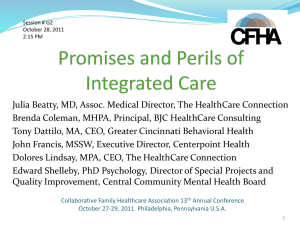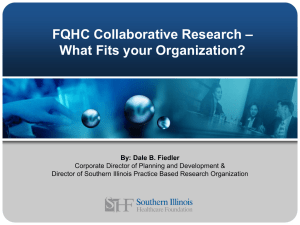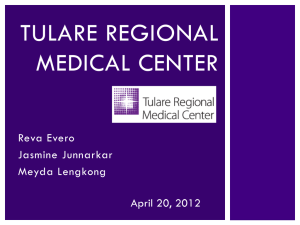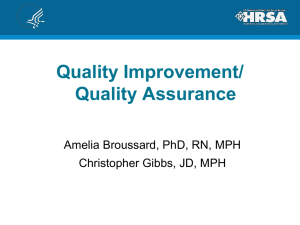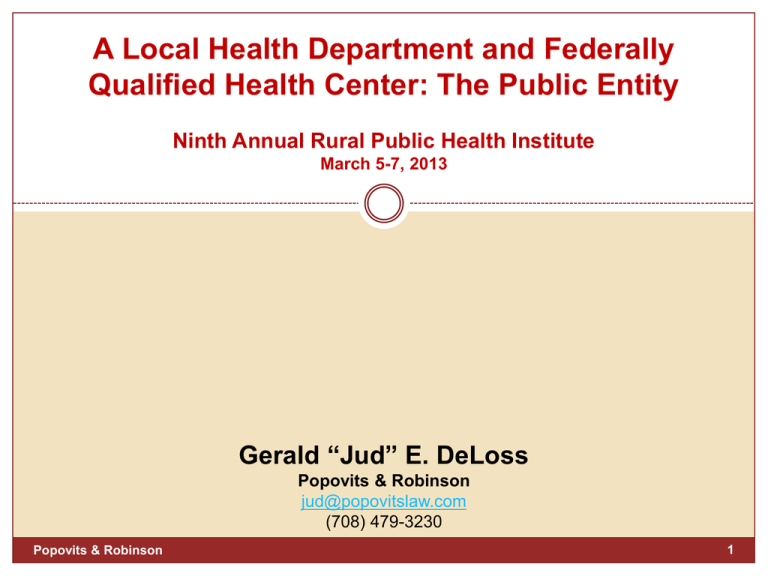
A Local Health Department and Federally
Qualified Health Center: The Public Entity
Ninth Annual Rural Public Health Institute
March 5-7, 2013
Gerald “Jud” E. DeLoss
Popovits & Robinson
jud@popovitslaw.com
(708) 479-3230
Popovits & Robinson
1
Legal Issues Confronting the FQHC and
Public Health Department
Popovits & Robinson
2
Federal Tort Claims Act
o
o
o
Under the Public Health Service Act, employees of eligible
FQHCs may be deemed to be federal employees qualified
for protection under the FTCA
There is no cost to participating FQHCs or their providers,
and they are not liable for any settlements or judgments
The FQHC, their employees, and eligible contractors are
considered federal employees immune from suit for medical
malpractice claims while acting within the scope of their
employment
Popovits & Robinson
3
Federal Tort Claims Act
o Deemed FQHC grantees are immune from
medical malpractice lawsuits resulting from:
o
o
o
o
o
Medical
Surgical
Dental
Related functions
Within the approved scope of project
Popovits & Robinson
4
Federal Tort Claims Act
o Eligible FQHCs must submit an original deeming and
annual renewal deeming applications
o A patient who alleges acts of medical malpractice by
a deemed FQHC cannot sue the center or the
provider directly, but must file the claim against the
US Government
o These claims are reviewed and/or litigated by HHS
Office of the General Counsel and DOJ
Popovits & Robinson
5
FTCA - Eligibility
o FTCA Grantees eligible to be deemed are:
o Community Health Centers (CHC)
o Migrant Health Centers (MHC)
o Health Care for the Homeless (HCH) Health Centers
o Public Housing Primary Care (PHPC) Health Centers
o Subrecipients eligible for FTCA coverage
Popovits & Robinson
6
FTCA - Subrecipient
o What is a subrecipient?
o Defined as an entity (not an individual contractor) that receives
a grant or a contract from a deemed FQHC
o Provides the full range of health services on behalf of the
deemed FQHC
o Only for those services under the scope of the project
o Contractual relationships with other entities for
individual services (e.g., laboratory, pharmacy,
physician services) are not subject to FTCA
coverage
Popovits & Robinson
7
FTCA - Coverage
o FTCA is only available for:
o FQHC
o Full or part-time FQHC employees
o Individually contracted providers who furnish services in the
fields of:
o
o
o
o
o
o
General internal medicine
Family practice
General pediatrics
OB/GYN
Individually contracted providers who furnish services in other
fields of practices on full-time basis
A contract between a FQHC and a provider's corporation does
not confer FTCA coverage on the provider
Popovits & Robinson
8
FTCA - Coverage
o Coverage/Protection for Covered individuals
o FTCA similar to occurrence insurance policy
o Do not need to purchase tail coverage
o Non-Covered Individuals
o Individuals who do not meet the statutory requirements for
covered individuals
o Examples include:
o
o
o
Volunteer physicians
Part-time (less than 32.5 hours) contract dentists
The FQHC remains covered, while the individual is not
Popovits & Robinson
9
FTCA – Specific Situations
o Indemnification of Other Entities
o
FTCA coverage does not extend to
indemnification or hold harmless of other
entities
o Governing Board Members and
Officers
o
The governing board members and officers are
covered under the FTCA only for medical
malpractice
Popovits & Robinson
10
FTCA - Coverage
o Covered Activities
o FTCA coverage is restricted to scope of employment
o For actions to be within the scope of employment, they must
occur during the provision of services to the FQHC’s patients
and, in certain circumstances, to non-FQHC patients
o The FQHC is responsible to maintain current records
Popovits & Robinson
11
FTCA - Coverage
o Scope of Employment
o Includes performance under a contract
o All covered individuals should have current, written job
descriptions
o FTCA matters may come to litigation, so job descriptions play
a key role in demonstrating scope of employment and FTCA
coverage
o Moonlighting is not within the scope of project
Popovits & Robinson
12
FTCA - Coverage
o Scope of Project
o FTCA coverage is limited to the performance of medical,
surgical, dental, or related functions
o New services and sites are dependent on approval of a
change in the scope of the project
o A request for a change in scope should be submitted
to HRSA/BPHC for approval
Popovits & Robinson
13
FTCA - Coverage
o Services to FQHC Patients
o A patient-provider relationship must be established
o For purposes of FTCA coverage, the patient-provider
relationship is established when:
o
o
o
Individuals access care for initial or follow-up visits at
approved sites
Individuals access care at approved sites even if not
permanent residents
Triage services are provided by telephone or in person, even if
patient is not yet registered but is intended to be registered
Popovits & Robinson
14
FTCA – Coverage
o FTCA coverage for services to non-FQHC patients is
available in certain situations
o Examples of Covered Services to Non-FQHC
Patients:
o
o
o
Community-Wide Intervention School-Based Clinics
School-Linked Clinics
Health Fairs
Popovits & Robinson
15
FTCA – Particularized Determination
o Other examples of Covered Services to Non-FQHC
Patients:
o Immunization Campaigns
o Migrant Camp Outreach
o Homeless Outreach
o Hospital-Related Activities
o Coverage-Related Activities
Popovits & Robinson
16
FTCA – Particularized Determination
o Acts and omissions related to services for non-
FQHC patients may be covered if approved
particularized determination of FTCA coverage
o The application for a particularized determination
must provide:
Services to non-FQHC patients will benefit FQHC
patients and general populations
o Services to non-FQHC patients facilitates the
provision of services to FQHC patients
o Such services are otherwise contractually-required
o Request for a particularized determination of FTCA
coverage must include sufficient detail
o
Popovits & Robinson
17
FTCA - Coverage
o Continuity of care
o Covered individual may follow FQHC patient to non-FQHC site
to maintain continuity of care
o Supervision of non-FQHC staff
o Supervision of Students and Medical Residents
o Activities under other grant funding
o Clinical research
o Assisting with community events
Popovits & Robinson
18
FTCA – Coverage Under Alternate Billing
o FQHC providers may bill directly for services
provided to FQHC facility patients
o If employee or contract provider, meeting all other
FTCA requirements bills for a service delivered at a
location not within its scope of project, FTCA
coverage will apply to the provider
Popovits & Robinson
19
FTCA – Coverage in Emergencies
o Emergency situations
o FTCA coverage will apply to the performance of
medical, surgical, dental, or related functions at
temporary locations
o If covered individuals volunteer in their individual
capacity to respond to an emergency, they will not
be protected under FTCA
o Patients served by covered individuals at temporary
locations are considered the FQHC’s patients
Popovits & Robinson
20
FTCA – Coverage in Emergencies
o In rare cases emergency may impact an entire
region or State
o If site of FQHC in the impacted area is destroyed or
unable to operate, FQHC may submit a request for
prior approval to temporarily change its scope of
project
o If covered individuals volunteer in their individual
capacity to respond to an emergency they will not be
protected under FTCA
Popovits & Robinson
21
FTCA – Coverage in Emergencies
o In emergency situations, FQHCs that are not directly
impacted by the emergency may:
o
o
Assist at temporary sites within the FQHC’s own service
area and within neighboring counties, parishes, or
political subdivisions
Operate temporary sites within the service area and
within neighboring counties, parishes, or political
subdivisions by including the temporary locations within
the scope of project
Popovits & Robinson
22
FTCA – Public Health Department
o FTCA coverage is available only to the
FQHC and individuals identified above
o Cannot be extended to the Health
Department or its employees
o Unless they are individually contracted to
the FQHC
o Satisfy the above-mentioned criteria for
individual coverage
Popovits & Robinson
23
FTCA – Acceptance by Hospitals and
Managed Care Plans
o Covered individual cannot be denied hospital
privileges solely because malpractice protection is
FTCA
o Managed care plans, including HMOs and similar
entities, must accept FTCA coverage as meeting
malpractice insurance coverage requirements
o Hospitals or managed care plans that fail to comply
in jeopardy of losing ability to collect payment under
Medicare and Medicaid
Popovits & Robinson
24
FTCA - Insurance
o FQHC has option to meet malpractice liability through FTCA or private insurance
o FQHCs not applied for, or have terminated FTCA, may use Federal grant funds for
o
o
o
o
private malpractice insurance
Dual coverage (i.e., both FTCA and private malpractice insurance covering the
same activities) is not permitted
US Government may subrogate claims where FQHC has private coverage and
payment is made under FTCA
Gap Coverage non-covered activities or non-covered individuals
Even with FTCA coverage, FQHCs will continue to need other types of insurance:
o
o
o
o
o
Non-medical/dental professional liability coverage
General liability coverage
D & O coverage
Automobile and collision
Fire and theft coverage
o FQHC applying for initial FTCA deeming, should have private malpractice insurance
in place until deemed
Popovits & Robinson
25
FTCA – Legal Claim Procedure
Popovits & Robinson
26
FTCA – Legal Claim Procedure
o Statute of Limitations
o Claim must be presented within two years after the
claim accrues
o Generally, accrual occurs on the date of the injury
o However, also incorporates a discovery rule
o State statute of limitations periods do not apply to
claims filed under the FTCA.
Popovits & Robinson
27
FTCA - Deeming
o To be deemed, a grantee or subrecipient must
complete an application that demonstrates that it:
o
o
o
o
Risk management policies and procedures
Credentialing and privileging system
Has no history of claims or, if such a history exists, has fully
cooperated with DOJ
Cooperate to provide information related to a claim
Popovits & Robinson
28
FTCA – Deeming Process Tips
o Deeming applicants must:
o Submit FTCA application materials in a timely manner
o Respond in a timely manner to all requests from HRSA
o Demonstrate implementation of the required policies
o Accurately present all material facts
o HRSA’s goal to support all FQHCs in successfully
demonstrating compliance with and implementation
of these requirements
Popovits & Robinson
29
FTCA – Deeming Process Tips
o Due to the number of applications, application
requirements, and potential for incomplete application
submissions, grantees should request FTCA coverage at
least 90 days in advance
o HRSA will conduct its review within 30 days
o If additional information or clarification is needed, HRSA
will notify the grantee through the EHB, and the grantee
will be given 10 business days to provide the requested
information
o Should the requested information not be submitted within
10 business days of notification, the applicant will be
required to submit a new application
Popovits & Robinson
30
FTCA – Additional Requirements
o Health Center policies and procedures for the following must
be included:
o
o
o
Referral tracking
Hospitalization tracking
Diagnostic tracking
o Statement verifying that any professional liability claims were
internally analyzed
o Statement should include the following for each claim filed
within the last five years:
o
o
o
o
o
Name of provider(s) involved
Area of practice/Specialty
Date of occurrence
Summary of allegations
Status and outcome of claim
Popovits & Robinson
31
FTCA – Additional Requirements
o Electronic Signature of the Executive Director
o Deeming Applications for any subrecipient(s)
o Considered part of the deeming application of the grantee
o Deeming applications by eligible entities must be
submitted in the form and manner prescribed by
HRSA and must demonstrate that the entity seeking
FTCA coverage has successfully implemented all
deeming requirements set forth in law
Popovits & Robinson
32
FTCA – Annual Renewal
o All currently deemed grantees must submit a FTCA
renewal application for themselves and any
subrecipients
o If additional information or clarification is needed to
support the application, HRSA will notify the grantee
and the grantee will be given ten (10) business days
to provide the additional information
Popovits & Robinson
33
FTCA – Site Visits
o HRSA may elect to conduct a site visit at any point
during the application review process and/or as part
of its oversight responsibilities
o Factors that may prompt a site visit include, but are
not limited to:
o
o
o
o
o
Submission of an initial FTCA deeming application
Unresolved questions identified during the review of the
FQHC’s application
Need for follow-up based on prior site visit findings or other
identified issues
History of repeated pertinent conditions
History of claims
Popovits & Robinson
34
FTCA – Site Visits
o Site visit reviewers will assess whether applicant:
o Risk management policies and procedures
o Credentialed and privileged its physicians and other licensed
or certified health care practitioners
o Has history of claims, then may validate that the grantee has
fully cooperated with the Attorney General in defending
against any such claims and has taken necessary corrective
steps to assure against future claims
Popovits & Robinson
35
FTCA - Risk Management
o PHS Act requires as condition of deeming, to
determine that the entity has implemented
“appropriate policies and procedures to reduce the
risk of malpractice and the risk of lawsuits arising out
of any health or health-related functions performed
by the entity
Popovits & Robinson
36
Risk Management Program
o Risk management program is critical:
o
o
o
Promote safe and effective patient care practices
Maintain a safe working environment
Protect FQHC’s financial resources
Popovits & Robinson
37
Risk Management Program
o Effective program can:
o
o
o
o
Identify and mitigate liability exposures
Prevent and reduce the severity of adverse
events
Improve patient experience
Increase provider and staff satisfaction
Popovits & Robinson
38
Risk Management Program
o Value to FQHC:
o Secure commitment to improve
o Review injuries, adverse events, and near misses to prevent
re-occurrence
o Promote system improvement
o Reduce liability exposure
o Encourage open communication among providers and staff
o Establish a culture of safety
Popovits & Robinson
39
Risk Management Program
o Key principles of the program include:
o Claims management
o Complaint resolution
o Confidentiality and release of patient information
o Event investigation, root-cause analysis, and follow-up
o Failure mode and effects analysis
o Provider and staff education, competency validation, and
credentialing requirements
o Reporting and management of adverse events and near
misses
o Trend analysis of events, near misses, and claims
Popovits & Robinson
40
Risk Management Program
o Risk management program should be administered
through the Risk Manager who reports to the
administrator/CEO
o Risk Manager should interact with administration,
staff, medical providers, and other professionals
o Risk Manager should chair the Risk Management
Committee
Popovits & Robinson
41
FTCA – Credentialing and Privileging
o Entity must review and verify “the professional
credentials, references, claims history, fitness,
professional review organization findings, and
license status of its physicians and other licensed or
certified health care practitioners ….”
Popovits & Robinson
42
FTCA – Credentialing Details
o Credentialing of Licensed Independent Practitioners (LIPs) requires
primary source verification of:
o
o
o
o
Current licensure
Relevant education, training, or experience
Current competence
Health fitness, or the ability to perform the requested privileges
o Credentialing of LIPs requires secondary source
verification of:
o
o
o
o
o
o
Government issued ID
DEA registration
Hospital privileges
Immunization and PPD status
Life support training
Query of the National Practitioner Data Bank (NPDB)
o Determination that LIP meets credentialing requirements by FQHC’s
governing board
Popovits & Robinson
43
FTCA – Credentialing Details
o Credentialing of other health care practitioners requires
primary source verification of:
o
o
o
License, registration, or certification
Education and training may be verified by secondary source
verification
Verification of current competence through review of clinical
qualifications and performance
o Credentialing of other health care practitioners requires
secondary source verification of the following:
o
o
o
o
o
Government issued ID
Immunization and PPD status
DEA registration
Hospital admitting privileges
Life support training
Popovits & Robinson
44
FTCA – Credentialing and Privileging
o Licensed and certified staff members at all FQHC sites
including employed or contracted practitioners,
volunteers and locum tenems, must include evidence of
credentialing and privileging within the last two years
o Credentialing list must include the following:
o
o
o
o
o
o
o
Name and Professional Designation (e.g., MD/DO, RN, CNM, DDS,
LPN, PA, MA, NP, etc.)
Title/Position
Specialty
Employment Status (full-time employee, part-time employee,
contractor or volunteer)
Hire Date
Current Credentialing Date (must be within past two years)
Next Expected Credentialing Date (if known)
Popovits & Robinson
45
FTCA - Privileging
o Revision or renewal of a privileges at least every 2 years
o Include synopsis of peer review results for the 2 year
o
o
o
o
period and/or any relevant performance improvement
information
Approval of subsequent privileges vested in the board
The FQHC should have an appeal process LIPs
Appeal process is optional for other licensed or certified
health care practitioners.
NOTE: FTCA requirements may not be the same as
accreditation-related standards
o
FQHCs that are accredited or seeking accreditation should also
review the applicable accreditation body standards
Popovits & Robinson
46
Credentialing & Privileging - Board
o FQHC’s credentialing and privileging policies and
procedures must include documentation of Board
approval
o Credentialing and privileging policies and procedures
must be approved, signed and dated by the Board
Popovits & Robinson
47
FTCA - Quality Improvement/Quality Assurance
o Initial or renewal application must contain Quality
Improvement/Quality Assurance (QI/QA) Plan
o
o
Clear documentation that the Board reviewed and approved
the plan within three (3) years of the date of submission
QI/QA plan must be approved, dated, and contain the
appropriate signature(s) of the Board of Directors
Popovits & Robinson
48
FTCA - Quality Improvement/Quality Assurance
o Minutes from any six Board meetings evidencing
oversight of QI/QA activities - must provide an
explanation if less than six sets of minutes are
provided
Popovits & Robinson
49
Quality Improvement/Quality Assurance
o FQHC has an ongoing Quality Improvement/Quality
Assurance (QI/QA) which must include:
o
o
o
o
o
Clinical director
Periodic assessment of the appropriateness of the utilization
of services and the quality of services provided
Conducted by physicians or by other licensed health
professionals under the supervision of physicians
Based on the systematic collection and evaluation of patient
records
Identify and document the necessity for change in the
provision of services by the FQHC
Popovits & Robinson
50
Quality Improvement/Quality Assurance
o The clinical director must have clear responsibility for
conducting QI/QA assessments/activities
o
May be full or part time staff, and should have appropriate
training/background (MD, RN, MPH, etc.), as determined by
the needs/size of the FQHC
o Plan must measure and evaluate patient satisfaction
o The FQHC must have clinical information systems in
place for key performance data
o The findings of the QI/QA process are used to
improve organizational performance
Popovits & Robinson
51
State Tort Immunity
o Illinois provides limited immunity from tort lawsuits
o Local Governmental and Governmental Employees
Tort Immunity Act
o Provides for coverage for medical facilities, public
health clinic, and physicians
o Coverage available for certain injuries and claims
o Each entity must make its own specific determination
of whether it falls under the protections of the Act
and/or whether the FQHC/Health Department is
immunized for its actions/inactions
Popovits & Robinson
52
State Tort Immunity
o Many public and local hospitals and medical centers are
protected from medical malpractice claims by the Act
o Generally, failure to diagnose or treat a patient at a public
health facility is immunized by the Act
o However, public medical personnel and entities are not
immune from:
o
o
Negligently or wrongfully prescribing treatment
Negligence, wrongful act, or omission in administering the prescribed
treatment
o The Act may not immunize actions or omissions by
“independent contractors”, who are not deemed
“employees”
Popovits & Robinson
53
Governance
o Organizations must have a governing body which
assumes full authority and oversight responsibility for
the FQHC
o The governing board must maintain an acceptable
size, composition, and meeting schedule
o The board must have the authority to control the
FQHC's budget and major resource decisions, set
center policies, and approve the selection and
dismissal of the FQHC program director or chief
executive officer
Popovits & Robinson
54
Governance
o FQHC must have governing body which:
o
o
Meets at least once a month, selects the services to be
provided by the center, schedules the hours during
which services will be provided, approves the center's
annual budget, approves the selection of a director for
the center, and, except in the case of a public center
(as defined in the second sentence of this paragraph),
establishes general policy for the center
In the case of the application for a second or
subsequent grant for a public center, has approved the
application or, if the governing body has not approved
the application, the failure of the governing body to
approve the application was unreasonable
Popovits & Robinson
55
Governance – Public Entities
o Public entities operating FQHC programs may meet the
governance requirement in either of two ways
o
o
The public entity's board may meet FQHC board composition
requirements including having a consumer majority
When the public entity's board does not meet FQHC composition
requirements, a separate FQHC governing board may be
established
o FQHC board can be a formally incorporated entity and it and
the public entity board are co-applicants for the FQHC
program
o When there are two boards, each board's responsibilities must
be specified in writing so that the responsibilities for carrying
out the governance functions are clearly understood.
o Upon showing of good cause the Secretary may waive all or
part of the requirements
Popovits & Robinson
56
Governance
o Public centers with co-applicant boards must meet
all the membership requirements and perform all the
responsibilities expected of governing boards
o Except co-applicant board is permitted to retain
authority for establishing general policies (fiscal and
personnel policies)
Popovits & Robinson
57
Governance
o FQHC’s board:
o Meets monthly
o FQHCs with approved waivers ONLY may have appropriate
strategies in place to ensure regular oversight, if the board
does not meet monthly
o Reviews and approves the annual FQHC (renewal) application
and budget
o Conducts an annual review of the CEO’s performance
Popovits & Robinson
58
Governance
o FQHC’s board:
o Reviews and approves the services to be provided and the
FQHC’s hours of operation
o Measures and evaluates the FQHC’s progress in meeting
annual and long term clinical and financial goals
o Engages in strategic and/or long term planning for the FQHC
Popovits & Robinson
59
Governance
o FQHC’s board:
o Reviews mission and bylaws on a periodic basis
o Receives appropriate information that enables it to evaluate
FQHC patient satisfaction, organizational assets, and
performance
o Establishes the general policies, including:
o
o
o
o
Personnel
Health care
Fiscal and quality assurance/improvement
With the exception of fiscal and personnel policies in the case of a
public agency grantee in a co-applicant arrangement
Popovits & Robinson
60
Governance - Public Health Department
o For Public Center Grantees with Co-Applicant
Arrangements only—Public center grantee has a
formal co-applicant agreement:
o
o
Roles, responsibilities, and the delegation of authorities
Any shared/split responsibilities between the public center and
co-applicant board
Popovits & Robinson
61
Governance
o The FQHC governing board must be composed of
individuals, a majority of whom are being served by the
center and, this majority as a group, represent the
individuals being served by the center in terms of
demographic factors such as race, ethnicity, and sex
o Governing board has at least 9 but no more than 25
members
o The remaining non-consumer members of the board
shall be representative of the community
o No more than one half (50%) of the non-consumer board
members may derive more than 10% of their annual
income from the health care industry
Popovits & Robinson
62
Governance
o A majority (at least 51%) of the board members
receive services (i.e., are patients) at the FQHC
o There is no established ratio for board members to
population served; however, board composition must
be reasonably representative of the populations
being served
o FQHCs with approved waivers only–appropriate
strategies are in place to ensure consumer/patient
participation and input from the target population
Popovits & Robinson
63
Governance
o FQHC bylaws or written corporate board approved
policy include provisions that prohibit conflict of
interest by board members, employees, consultants,
and those who furnish goods or services
o No board member shall be an employee of the
FQHC or an immediate family member of an
employee
o CEO may serve only as a non-voting ex-officio
member of the board
Popovits & Robinson
64
Governance
o The FQHC’s conflict of interest policy must address:
o
o
o
o
o
o
o
o
Disclosure of business and personal relationships, including
nepotism
Extent to which a board member can participate in board decisions
where the member has a personal or financial interest
Using board members to provide services to the center
Expense reimbursement policies
Acceptance of gifts and gratuities
Personal political activities of board members
Consequences for violating the conflict policy
Written standards of conduct governing the performance of its
employees engaged in the award and administration of contracts
Popovits & Robinson
65
Governance
o Options to assist the FQHC in its assessment of
health service needs of special populations:
o
o
o
o
Inclusion on the board of persons who previously have been
FQHC consumers, but no longer receive services
Use of an advisory board
Focus groups comprised of FQHC consumers
Representatives of other service organizations and/or local
advocacy groups
Popovits & Robinson
66
Relationship Between FQHC and
Public Health Department
o Relationship Models:
o One organization refers its patients to the other organization
for services (referral arrangement)
o One organization co-locates to the other organization’s facility
(co-location arrangement)
o FQHC purchases services and/or capacity from the health
department (purchase of services arrangement)
Popovits & Robinson
67
Relationship Between FQHC and
Public Health Department
o Referral Arrangement Considerations
o Under a referral arrangement, both the FQHC and
the health department typically continue to perform
the same scope of services
o All services provided within an FQHC’s scope of
project via referral to another provider must be
provided through a formal referral arrangement
Popovits & Robinson
68
Relationship Between FQHC and
Public Health Department
o Under referral arrangement, the FQHC and the
health department maintain their own employees
and contractors
o Credentialing requirements, by-laws and clinical
policies of the organization providing services govern
o FTCA coverage is available to the FQHC if it is the
referral provider
o FTCA coverage is not available for the health
department or its contracted or employed health care
professionals
Popovits & Robinson
69
Relationship Between FQHC and
Public Health Department
o Co-Location Arrangements
o Relationship under which a provider agrees to treat
patients who are referred to it by another provider
o Maintains its own practice and control over the
provision of the referral services and is legally and
financially responsible for the referral services
o Health care professional furnishing the referral
services is physically located at the other
organization’s site
Popovits & Robinson
70
Relationship Between FQHC and
Public Health Department
o Co-Location Agreement
o Patients are simply referred to the health department
as they would be under a standard referral
relationship
o If FQHC establishes a site within the health
department, the FQHC must obtain prior approval
from HRSA to add the site to its scope of project
Popovits & Robinson
71
Relationship Between FQHC and
Public Health Department
o Lease of Space and/or Equipment
o FQHC and health department should execute a
lease covering the space, equipment, utilities,
supplies, and support personnel that will be utilized
by the co-located provider, as well as other
associated costs
Popovits & Robinson
72
Relationship Between FQHC and
Public Health Department
o Co-Location Agreement should contain assurances
from the co-located provider regarding professional
qualifications, licensure, certification, insurance,
eligibility to participate in federal programs with
regard to the other organization and its professionals
Popovits & Robinson
73
Relationship Between FQHC and
Public Health Department
o FTCA coverage is available if the FQHC co-locates
to an health department facility, adds the site to its
scope of project, and provides services within its
scope of project
o Under the co-location arrangement, FTCA coverage
is not available for the health department, its
employees and its contracted health care
professionals
Popovits & Robinson
74
Relationship Between FQHC and
Public Health Department
o Purchase of Services Arrangements
o One organization purchases services from the other
organization, which provides such services as a
vendor and on behalf of the other “purchasing”
organization
o FQHCs and health departments may enter into
arrangements for the purchase of administrative
services
Popovits & Robinson
75
Relationship Between FQHC and
Public Health Department
o The purchasing organization is the provider of record
for the contracted services rendered to patients
o Services provided by the vendor organization may
be provided at either the purchasing organization’s
facility or at the vendor organization’s facility
o FQHC and health department remain separate
entities
Popovits & Robinson
76
Relationship Between FQHC and
Public Health Department
o Purchase of Services Agreement
o If the service(s) provided to FQHC patients by the
contracted health department health care
professional(s) are not within the FQHC’s scope of
project, then the FQHC must request and obtain
prior approval from HRSA to add the services
o FQHC must confirm that the location qualifies as a
“site”
Popovits & Robinson
77
Relationship Between FQHC and
Public Health Department
o Reimbursement from Payors and Patients
o Patients served under this arrangement would be considered
FQHC patients for all services provided and, the FQHC would
bill appropriate third party payors and collect any fees from
patients
Popovits & Robinson
78
Relationship Between FQHC and
Public Health Department
o Purchase of Services Agreement should include
provisions to ensure that the health department
health care professional provides services to the
FQHC patients in the same manner as if the FQHC
was providing the services directly
Popovits & Robinson
79
Relationship Between FQHC and
Public Health Department
o Agreement must be directly between the FQHC and
the individual health professional providing services
o Agreement between the FQHC and health
department will not extend FTCA coverage to the
individual health professional who is an health
department employee
Popovits & Robinson
80
Relationship Between FQHC and
Public Health Department
o Additional legal issues that should be addressed in structuring
FQHC-health department partnerships:
o
o
o
o
o
o
o
o
o
o
o
o
o
o
Federal tax considerations
Federal fraud and abuse law (e.g., anti-kickback, false claims)
Federal physician self-referral law (Stark)
Federal Antitrust law
HIPAA and 42 CFR Part 2
HHS Uniform Administrative Requirements
State counterparts to federal laws, including fraud, abuse, and self-referral
Clinic licensure and certificate of need laws
Professional licensure, certification and/or other authorization to render services
Zoning laws
Corporation/LLC statutes
Privacy of patient health information
Insurance
Scope of practice (including supervision requirements for non-physician
providers
Popovits & Robinson
81
Questions/Follow-up
Gerald “Jud” E. DeLoss
Popovits & Robinson
jud@popovitslaw.com
(708) 479-3230
www.popovitslaw.com
Popovits & Robinson
82


